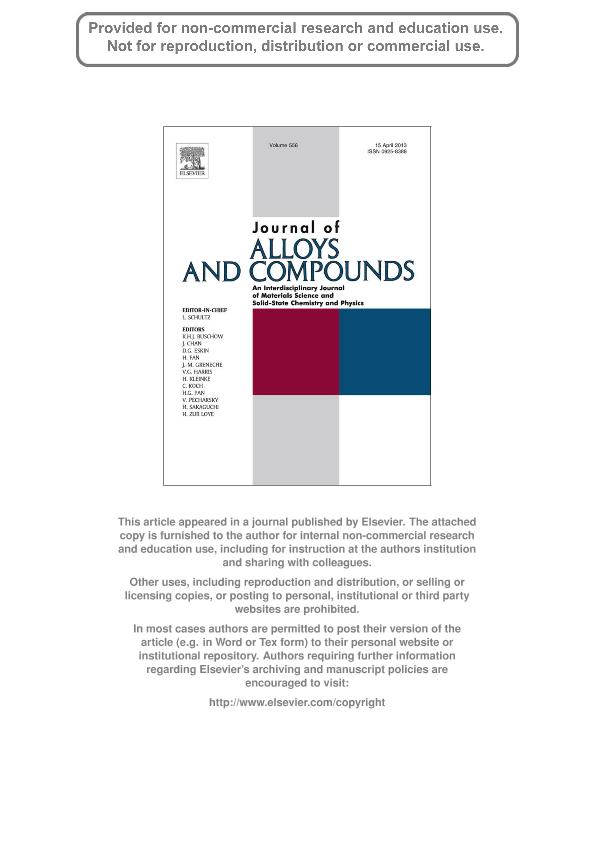Mostrar el registro sencillo del ítem
dc.contributor.author
Luna, Carla Romina

dc.contributor.author
German, Estefania

dc.contributor.author
Macchi, Carlos Eugenio

dc.contributor.author
Juan, Alfredo

dc.contributor.author
Somoza, Alberto Horacio

dc.date.available
2016-09-02T20:26:24Z
dc.date.issued
2013-01
dc.identifier.citation
Luna, Carla Romina; German, Estefania; Macchi, Carlos Eugenio; Juan, Alfredo; Somoza, Alberto Horacio; On the perfect MgH2(-Nb,-Zr) systems and the influence of vacancy-like defects on their structural properties. A self-consistent first principle calculations study of the electron and positron parameters; Elsevier; Journal of Alloys and Compounds; 556; 1-2013; 188-197
dc.identifier.issn
0925-8388
dc.identifier.uri
http://hdl.handle.net/11336/7415
dc.description.abstract
The electronic and structural properties of MgH2 systems containing vacancies and Zr or Nb as dopants were studied using self-consistent calculations. The density of states were computed using the Vienna Ab initio Simulation Package (VASP) and the orbital overlap population weighted DOS with the Amsterdam Density Functional program. The metal–metal and metal–hydrogen bonds in the perfect hydride and this material containing a neutral Mg or H vacancies or a neutral mixed Mg–H vacancy complex were analyzed. The same calculations were also performed in the magnesium hydride with a Nb or a Zr atom as a substitutional impurity and on these systems containing the above mentioned vacancies. Simultaneously, the influence of vacancies in the hydride was studied through the calculation of the positron lifetimes and the positron–electron momentum distributions in the previously referred materials. Secondly, information on the influence of vacancies on the electron momentum density of the MgH2(–Nb,–Zr) systems was additionally obtained through the calculation of the positron–electron momentum distributions. The results obtained indicate that in the pure hydride the presence of vacancies and impurities notable diminishes the force in the atomic bonds. The stability decrease of the bonds was correlated with changes in the positron wave function in the same sites of the structures. Moreover, it was found that these changes in the positron wave function are in good agreement with the decrease of the positron lifetimes.
dc.format
application/pdf
dc.language.iso
eng
dc.publisher
Elsevier

dc.rights
info:eu-repo/semantics/openAccess
dc.rights.uri
https://creativecommons.org/licenses/by-nc-nd/2.5/ar/
dc.subject
Mgh2
dc.subject
Vacancy
dc.subject
Positron
dc.subject
Hydrogen
dc.subject.classification
Física de los Materiales Condensados

dc.subject.classification
Ciencias Físicas

dc.subject.classification
CIENCIAS NATURALES Y EXACTAS

dc.title
On the perfect MgH2(-Nb,-Zr) systems and the influence of vacancy-like defects on their structural properties. A self-consistent first principle calculations study of the electron and positron parameters
dc.type
info:eu-repo/semantics/article
dc.type
info:ar-repo/semantics/artículo
dc.type
info:eu-repo/semantics/publishedVersion
dc.date.updated
2016-03-02T13:41:36Z
dc.journal.volume
556
dc.journal.pagination
188-197
dc.journal.pais
Países Bajos

dc.journal.ciudad
Amsterdam
dc.description.fil
Fil: Luna, Carla Romina. Universidad Nacional del Centro de la Provincia de Buenos Aires. Facultad de Ciencias Exactas. Instituto de Física de Materiales; Argentina. Consejo Nacional de Investigaciones Científicas y Técnicas; Argentina
dc.description.fil
Fil: German, Estefania. Universidad Nacional del Centro de la Provincia de Buenos Aires. Facultad de Ciencias Exactas. Instituto de Física de Materiales; Argentina. Consejo Nacional de Investigaciones Científicas y Técnicas; Argentina
dc.description.fil
Fil: Macchi, Carlos Eugenio. Universidad Nacional del Centro de la Provincia de Buenos Aires. Facultad de Ciencias Exactas. Instituto de Física de Materiales; Argentina. Consejo Nacional de Investigaciones Científicas y Técnicas; Argentina
dc.description.fil
Fil: Juan, Alfredo. Consejo Nacional de Investigaciones Científicas y Técnicas. Centro Científico Tecnológico Bahía Blanca. Instituto de Física del Sur; Argentina
dc.description.fil
Fil: Somoza, Alberto Horacio. Universidad Nacional del Centro de la Provincia de Buenos Aires. Facultad de Ciencias Exactas. Instituto de Física de Materiales; Argentina. Provincia de Buenos Aires. Gobernación. Comisión de Investigaciones Científicas; Argentina
dc.journal.title
Journal of Alloys and Compounds

dc.relation.alternativeid
info:eu-repo/semantics/altIdentifier/url/http://www.sciencedirect.com/science/article/pii/S092583881202364X
dc.relation.alternativeid
info:eu-repo/semantics/altIdentifier/doi/http://dx.doi.org/10.1016/j.jallcom.2012.12.121
Archivos asociados
